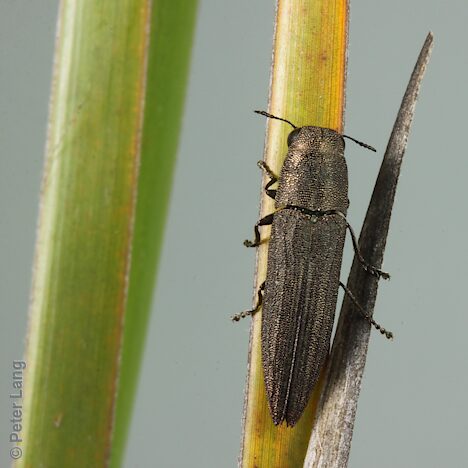
, SE, A2_x468.jpg)
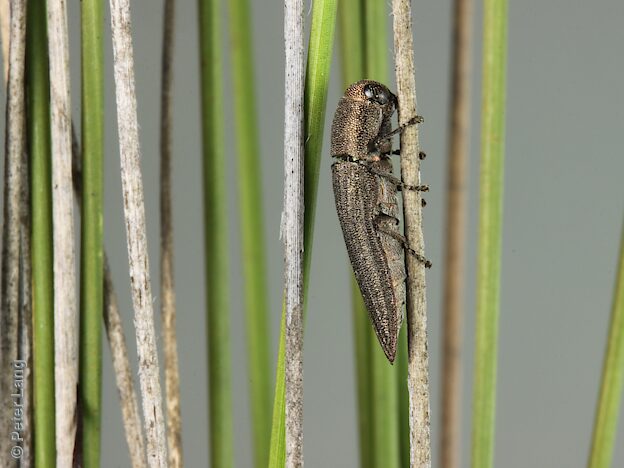
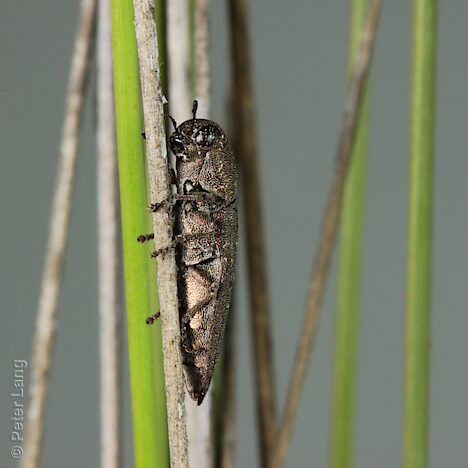
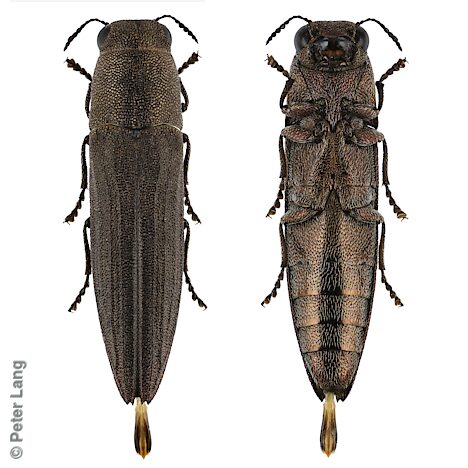
, SE, A6_x468.jpg)
, SE, A6.4_x300.jpg)
, SE, showing ovipositor, A6.5_x300.jpg)
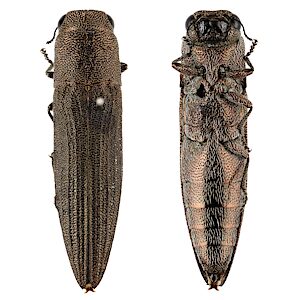
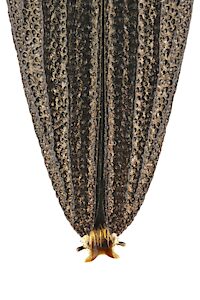
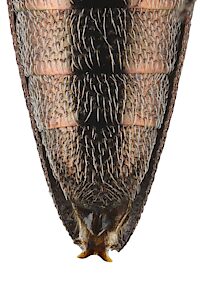
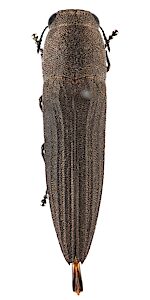
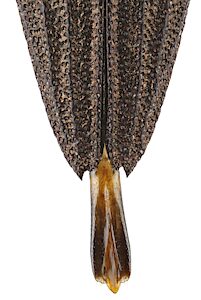
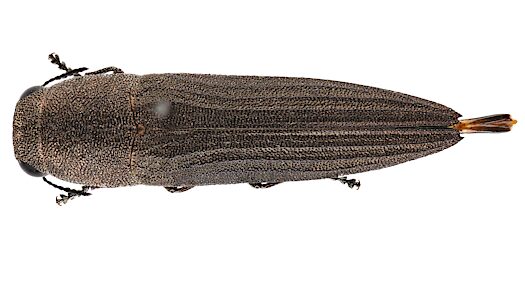
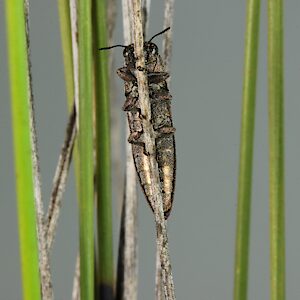
, SE, A7.5_x300.jpg)
, SE, A8_x300.jpg)
, SE, A9_x300.jpg)
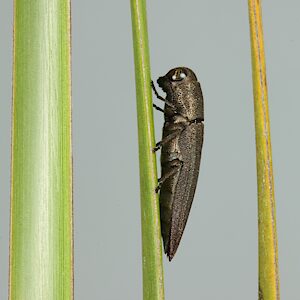
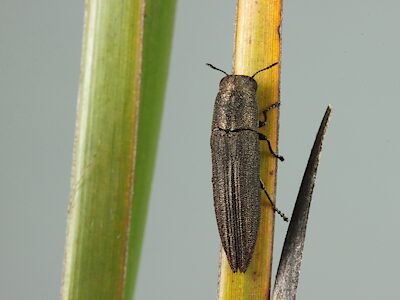
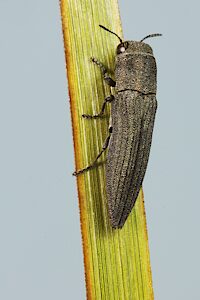
size¹:
×
2.2 mm

, SE, A2_x468.jpg)



, SE, A6_x468.jpg)
, SE, A6.4_x300.jpg)
, SE, showing ovipositor, A6.5_x300.jpg)







, SE, A7.5_x300.jpg)
, SE, A8_x300.jpg)
, SE, A9_x300.jpg)



| male | female | |||||
|---|---|---|---|---|---|---|
| L1 | 8.8 | 6.65 – 10.1 | n = 21 | 9.2 | 8.8 – 9.8 | n = 5 |
| L2 | 8.6 | 6.6 – 10 | n = 21 | 9.1 | 8.65 – 9.7 | n = 5 |
| W | 2.2 | 1.65 – 2.6 | n = 21 | 2.3 | 2.2 – 2.5 | n = 5 |
| Legend | L1 | length from clypeus/frons to elytral apex (mean, range, sample size) |
| L2 | length from anterior of edge of eyes to elytral apex | |
| W | maximum width with elytra fully closed |
Described by Blackburn 1887 as narrower and more cylindrical than Euryspilus chalcodes, with the elytra less pointed apically. It is also duller and somewhat dark grey-brown in colour compared to the more coppery-bronze and metallic appearance of E. chalcodes, and the ribbing on the elytra is less prominent.
The original description of this species by Blackburn 1887 as Eurybia australis was based on specimens (= syntypes) 'taken by Mr. J. Anderson and myself about six miles from Port Lincoln' on southern Eyre Peninsula. Blackburn distinguished it from Euryspilus chalcodes by its shape as well as differences in the ribbing and sculpturing of the elytra.
In October 2022 A.M.P. Stolarski made a series of collections from upper SE region which are presented here. They make a good match to an image taken by C. Bellamy of the Blackburn type specimen of E. australis at the British Museum of Natural History, particularly in the elongated pronotum shape, less acutely tapered apices, and dull rather dark brown coloration. They also closely match the only four pre-existing collections of South Australian Euryspilus in the SA Museum. Those collections had been identified as E. chalcodes and were formerly treated under that name on this website, but are now included here. One of them is from western Kangaroo Island, an area with a strong biogeographical connection to the southern end of Eyre Peninsula where Blackburn’s types were collected.
Carter 1924a considered E. australis as doubtfully distinct, having observed similar differences of sculpture within a series of E. chalcodes from south of Perth, and he suggested that the purported difference between the two species may actually be due to sexual dimorphism. This is not supported by an examination of male and female specimens of material attributable to E. australis from SA, which both appear quite different to specimens from south-western WA identified as E. chalcodes.
Euryspilus strandi (Obenberger 1921), which is treated as a synonym of E. australis on the Australian Fauna Directory ABRS 2020, also appears to be a different species to E. australis and more closely resembles specimens identified as E. chalcodes from south-western WA.
| Legend | P.J.Lang collection vouchered records | |
| other private collection or museum specimens, or sightings |
|
|
|
|
|
|
|
|
|
|
|
|
|
||||||||||||||||||||||||||||||||||||||||||||||||
|
|
|
|
|
|
|
|
|
|
|
|
|
||||||||||||||||||||||||||||||||||||||||||||||||
| Jul | Aug | Sep | Oct | Nov | Dec | Jan | Feb | Mar | Apr | May | Jun |
| Legend | live emerged adults, count > median value of 2 per quarter month | |
| live emerged adults, count <= median value of 2 | ||
| live non-emerged adults only, for that quarter month | ||
12 | number of active beetles for that quarter month |
| beetles | sites | SA regions¹ | family | position on host plant | |||
| Lepidosperma laeve | 9 | 2 | SE | C | |||
| Lepidosperma hispidulum | 8 | 2 | EP, SE | C | |||
| Lepidosperma viscidum | 2 | 1 | KI | C | |||
| Lepidosperma sp. | 2 | 2 | SE | C | |||
| Lepidosperma congestum | 1 | 1 | SL | C |
| Legend | beetles | count of beetles collected from, or sighted on, host plant taxon |
| sites | count of major sites (unique 10 km grid cells +/- some distinct approximate localities) | |
| Plant names in green are hyperlinked to a matching host species page with plant photos. | ||
| Code | beetles | % | host plant taxa | |
| C | Cyperaceae | 22 | 100% | 4 |
| position | beetles | sites | ||
| on foliage or non-flowering plant | 1 | 1 | ||
| on plant (unspecified) | 16 | 5 | ||
| other | ||||
| unknown | 5 | 3 | ||
The recent SA records of this species were obtained by general sweeping of ground layer vegetation in areas where Lepidosperma carphoides, L. hispidulum and L. laeve are prevalent. Some collections were also made by targeted sweeping of the last two species which are considered likely to be larval hosts. This is a significant departure from, E. chalcodes which is associated with Juncus in south-western WA (from the plant family Juncaceae, rather than Cyperaceae as for Lepidosperma).
| ¹ Legend | regions | SA State Herbarium regions (map) EA: Eastern, EP: Eyre Peninsula, FR: Flinders Ranges, GT: Gairdner-Torrens, KI: Kangaroo Island, LE: Lake Eyre, MU: Murray, NL: Northern Lofty, NU: Nullarbor, NW: North-Western, SE: South-Eastern, SL: Southern Lofty, YP: Yorke Peninsula |
| size | The ellipse is the correct size when printed, indicative on a desktop screen, and likely to be wrong on a mobile device. |